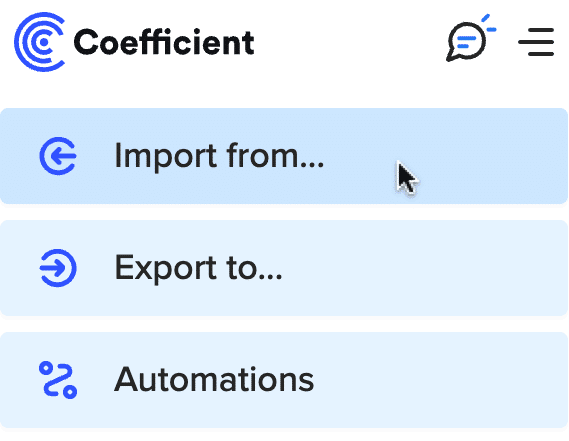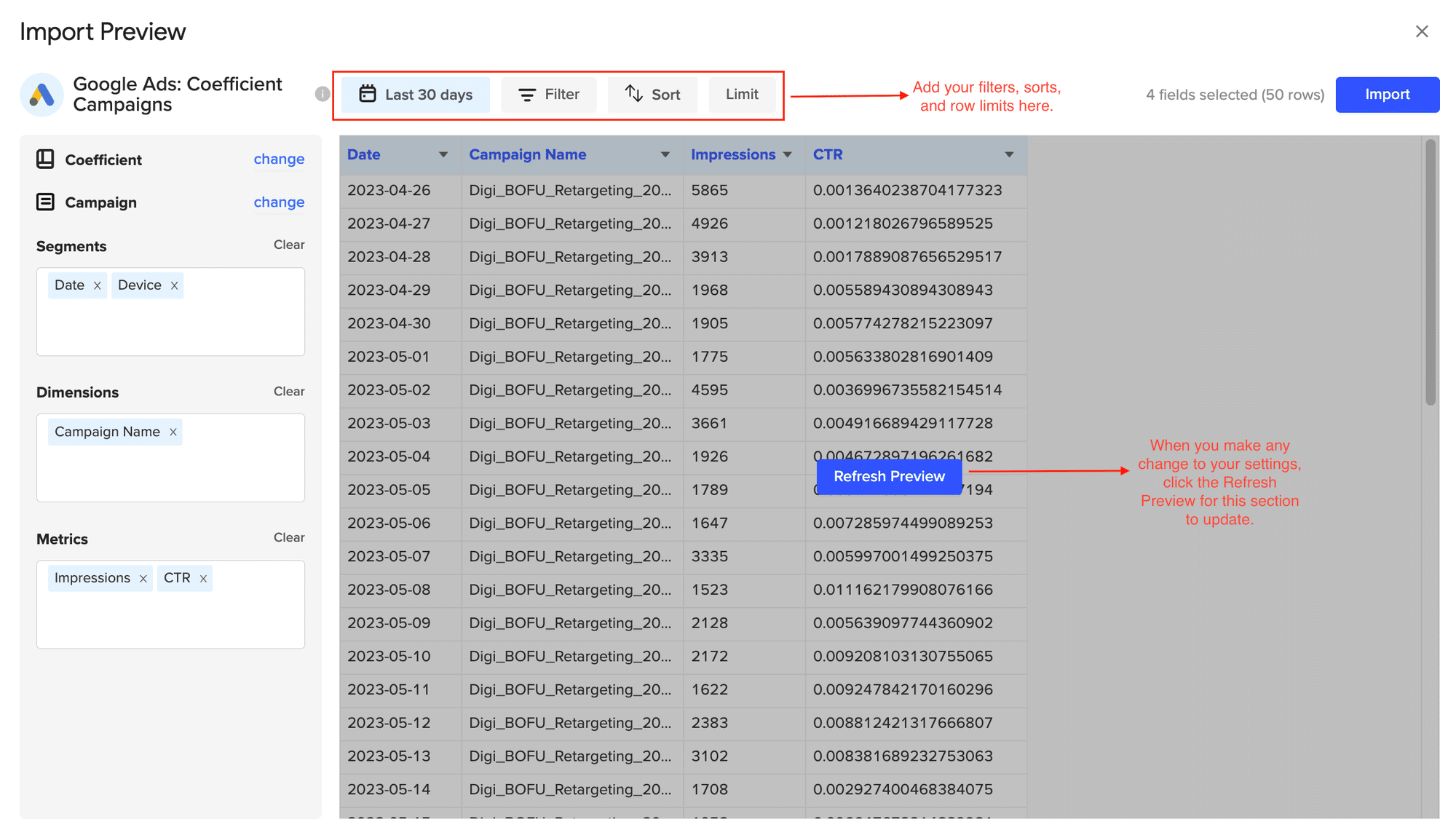Connecting Google Ads to Salesforce can transform your marketing efforts by providing deeper insights and more precise targeting. This integration allows you to use Salesforce data to optimize your Google Ads campaigns, measure advertising ROI accurately, and streamline lead management.
In this guide, we’ll explore three methods to connect Google Ads to Salesforce: Coefficient, Zapier, and Hevo Data. Each method offers unique benefits tailored to different business needs.
Advantages of Connecting Google Ads to Salesforce
- Optimize ad targeting: Use Salesforce customer data to create more targeted Google Ads campaigns based on customer behavior and preferences.
- Measure advertising ROI: Combine Google Ads data with Salesforce sales data to accurately measure the return on your advertising spend.
- Streamline lead management: Automatically create or update Salesforce leads based on Google Ads interactions, reducing manual data entry.
Connect Google Ads to Salesforce: 3 Methods
| Solution | Best For |
| Coefficient | Simple, no-code setup for both technical and non-technical users to connect Google Ads and Salesforce data. |
| Zapier | Easy to use task automation with a wide range of integrations, ideal for small to medium-sized businesses. |
| Hevo Data | Robust, real-time data pipeline for companies requiring secure and fault-tolerant data handling, albeit with a steeper learning curve. |
Method 1: Coefficient – No-Code, User-Friendly
Coefficient connects your spreadsheet to all your business data without a single line of code.
It provides a user-friendly interface and automatic data updates, making it a reliable option for both technical and non-technical users.
Pros
- Simple, no-code setup: Easy for anyone to use.
- Automatic data updates: Keeps your data fresh without manual effort.
- Affordable pricing plans: Suitable for various budget levels.
Cons
- Scheduled automations are not free: Requires a subscription for advanced features.
Step 1. Install Coefficient
For Google Sheets
Open a new or existing Google Sheet, navigate to the Extensions tab, and select Add-ons > Get add-ons.

In the Google Workspace Marketplace, search for “Coefficient.”

Follow the prompts to grant necessary permissions.

Launch Coefficient from Extensions > Coefficient > Launch.

Coefficient will open on the right-hand side of your spreadsheet.

For Microsoft Excel
Open Excel from your desktop or in Office Online. Click ‘File’ > ‘Get Add-ins’ > ‘More Add-Ins.’

Type “Coefficient” in the search bar and click ‘Add.’

Follow the prompts in the pop-up to complete the installation.
Once finished, you will see a “Coefficient” tab in the top navigation bar. Click ‘Open Sidebar’ to launch Coefficient.

Step 2. Importing Data from Google Ads
With Coefficient installed, you’re now ready to import your Google Ads data into your spreadsheet.
Click ‘Import from…’ from the Coefficient menu.

Navigate down the menu to find Google Ads. Click ‘Connect.’

Click ‘Authorize’ and follow the prompts to complete authorization.

Select ‘Start from Scratch’ after connecting Coefficient to your Google Ads account

Select your Google Ads account from the “Import Preview” window and click next to continue.

Select an object from those listed. (example: ”Campaign”). Popular objects are displayed at the top, but you can scroll down to find Other Objects.

Select fields for your Segments, Dimensions, and Metrics needed for your import. Click inside the white box area for each section to search for the fields you need. The data previewer shows a sample of the data from the fields you select.

7. Customize your import by adding filters, and row limits as needed. Click the “Refresh Preview” option to update the sample data based on what customizations are added. Click ‘Import’ when finished.

Coefficient will automatically push your Google Ads data to your spreadsheet!

Step 3. Export Data from Your Spreadsheet to Salesforce
Before starting, make sure you’ve connected to Salesforce.
Then, navigate to Coefficient’s menu. Click “Export to…”

Choose Salesforce from the list of available data sources.

Select the tab and header rows in your spreadsheet that contain the data you want to export.
Define your tab and header row.

Stop exporting data manually. Sync data from your business systems into Google Sheets or Excel with Coefficient and set it on a refresh schedule.
Get Started

Next, select the Salesforce Object you want to export data to, e.g., “Opportunity”, “Contacts”, etc.

Then, select the type of action you want to perform—Update, Insert, Upsert, or Delete.
Map the fields from your spreadsheet to the corresponding Salesforce fields.

(Optional) Specify additional settings such as batch size, whether to export empty cells on an update, and the column for results.

Note: Batch size is capped at 10,000 rows due to Salesforce API limitations.
Confirm your settings and click “Export”.

Then, highlight the rows you want to update or export. You can choose to export all rows or specific rows.

After you’re finished, review your settings and click “Export.”
Follow the prompts to confirm your changes.

In a few seconds, data from your spreadsheet will push to Salesforce.

Your spreadsheet will display updated records, along with their export status and the date/time stamp of the update.
Method 2: Zapier

Zapier is another effective tool for connecting Google Ads to Salesforce. It specializes in no-code automation and offers a wide range of integrations.
Pros
- No-code automation: Easy setup without coding skills.
- Wide range of integrations: Connects with more than 2,000 apps.
- User-friendly interface: Streamlined user experience.
Cons
- Limited handling of complex data transformations: Not suitable for highly complex needs.
- Costs can add up for premium features: Pricing may become significant for extensive use.
Step-by-Step Guide
Setting Up a Zapier Account
- Sign up for a Zapier account and log in.
Creating a Zap (Automation)
- Click on “Make a Zap” to start creating your automated workflow.
Configuring Triggers and Actions
- Select Google Ads as your trigger app and choose the trigger event (e.g., new ad lead).
- Connect your Google Ads account and test the trigger.
- Select Salesforce as the action app and choose the action event (e.g., create a new lead).
- Connect your Salesforce account and map the relevant fields from Google Ads to Salesforce.
Method 3: Hevo

Hevo provides a robust, real-time data transfer solution. It is secure, fault-tolerant, and relatively easy to use, albeit with a steeper learning curve than the previous two methods.
Pros
- Real-time data transfer: Ensures timely and accurate data.
- Secure and fault-tolerant: Reliable data handling and security.
- Easy to use: Intuitive interface despite initial setup complexity.
Cons
- Higher cost for advanced features: More expensive compared to basic integrations.
- Requires some setup: Not entirely no-code, requires some technical know-how.
Step-by-Step Guide
Setting Up Hevo Data
- Sign up for an account on the Hevo Data website.
- Follow the onboarding process to set up your workspace.
Connecting Google Ads
- In Hevo, go to integrations and connect your Google Ads account.
- Select the data fields and schema you wish to sync.
Mapping and Transferring Data to Salesforce
- Connect your Salesforce account under the destination settings.
- Map the Google Ads data fields to corresponding Salesforce fields.
- Set up the data pipeline and run the initial data load.
Connect Google Ads to Salesforce in Your Spreadsheet
Connecting Google Ads to Salesforce can significantly enhance your marketing data analysis and business operations. Whether you choose Coefficient for its simplicity, Zapier for its extensive integrations, or Hevo for its robust performance, each tool offers unique advantages.
Take the next step towards seamless data integration by trying Coefficient today.

